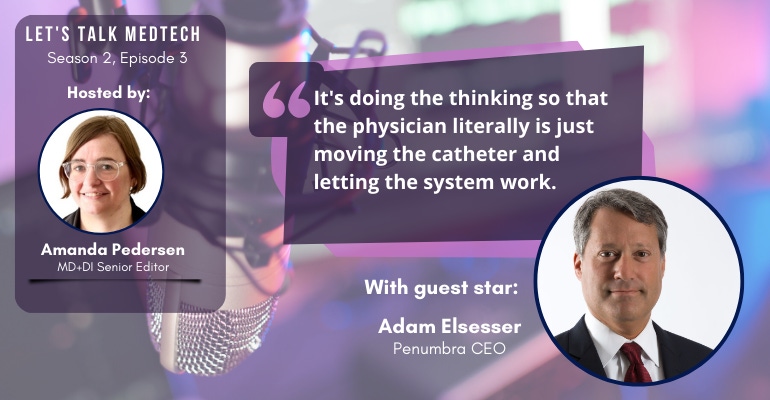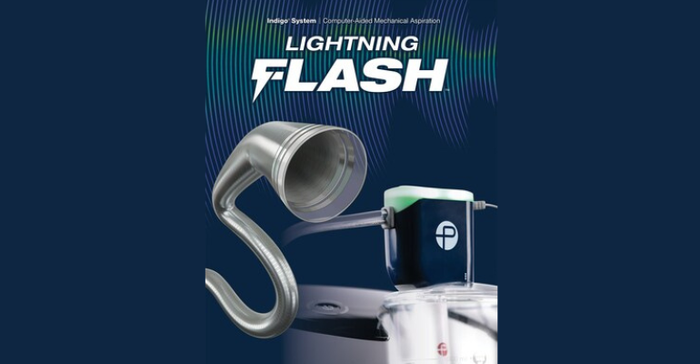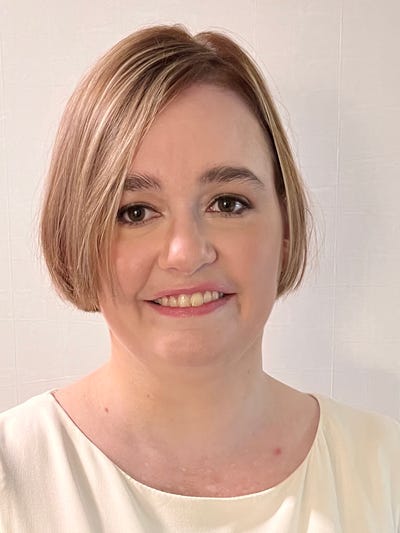Has Penumbra Caught Lightning in a Bottle?
Between its new Lightning Flash and soon-to-be launched Lightning Bolt, the mechanical thrombectomy device maker is having a stand-out year.
March 24, 2023

Penumbra, a company that has been dubbed one of the most attractive medtech M&A targets, might have caught lightning in a bottle with its computer-orchestrated mechanical thrombectomy technology designed to help physicians remove blood clots more quickly, while managing the risk of too much blood loss.
In January, the Alameda, CA-based company launched Lightning Flash, a mechanical thrombectomy system that features the company's new Lightning Intelligent Aspiration technology. The device is powered by the Penumbra Engine, which uses both pressure and flow-based algorithms to detect blood clot and blood flow. The Lightning Flash catheter is made with MaxID hypotube technology, allowing an inner diameter similar to large-bore catheters while maintaining a lower profile and a soft, atraumatic tip designed to help navigate the complex and delicate anatomy of the body.
At the end of March, Penumbra also plans to launch Lightning Bolt, a mechanical thrombectomy device intended for arterial use. The company also has another potentially paradigm-changing device in the pipeline called Thunderbolt, which is expected to be the first cyclical aspiration system on the market.
So, it seemed like a good time to have Penumbra CEO Adam Elsesser in the Let's Talk Medtech studio. Listen to the episode on the player below, or scroll down to read the transcripts.
Season 2, Episode 3 Transcripts
Adam Elsesser: So what if you fail? At a lot of companies, failure comes with sort of a political taint, you know, like, ‘oh, you were on that project.’
Amanda Pedersen: You're listening to Let's Talk Medtech. I'm Amanda Pedersen, senior editor at MD+DI, and in the studio with me today is Adam Elsesser, CEO at Penumbra. We're going to talk about the company's paradigm changing mechanical thrombectomy technology, how the company expects to hit a billion dollars in total revenue in 2023, and Adams attitude toward failure and innovation. So, without further ado, Let's Talk Medtech.
This is clearly an exciting time for Penumbra. You launched Lightning Flash in January, you're getting ready to launch Lightning Bolt here at the end of the month, and you've said that you expect to reach a billion dollars or more in revenue this year. So, Adam, how do you get there? What makes you confident in that projection?
Adam Elsesser: 2023 and beyond, I think, you know, we've talked about this being a consequential year, and what I mean by that term, the reason I used it, is this is really the beginning of, I think, the next phase of the company. So, we started the company almost 20 years ago with the initial thought of ‘can we remove blood clots from the arteries in your brain when you've had an acute ischemic stroke fast enough to matter to the patient and try to reverse, you know, the devastating effects of a stroke and give the patient a better shot at as much – or, in some cases – a full recovery? We've expanded to all the vascular beds in the body – the arteries in the rest of the body, the heart, the veins, and also the lungs, and that, you know, has been this journey of trying to get products and devices, you know, to be better and better and better. And we've gone through many, many iterations as we've continued on that journey because obviously if it was easy, it would have been done a long time ago. And it's not, it's hard. And we're now in the process of launching products that use a computer to sort of orchestrate the aspiration of that clot on things that can be now done automated and faster than the human body or the human hand. And so, we're really getting closer to our ultimate goal of being able to put a catheter at the clot, push a button, and the clot comes out. The procedure becomes very simple, sort of, you know, almost automatic. I'm sure there'll be some patients that's not true on … like anything's never 100%, but that's why it's consequential because this is the year that, I think, we see that that reality is in our reach. You know, for many, many years – as I said, almost 20 years – it's been a thought, a mission, a dream. We've been making good progress at it, but now we're getting to the point where I think we're going to see that reality.
Amanda Pedersen: You launched Lightning Flash in January and that features the company's new Lightning Intelligent Aspiration Technology. You've previously said that device will fundamentally change how blood clots are removed from the body. So, how is the launch going? And, have there been any surprises in terms of physician feedback?

Adam Elsesser: I wouldn't say, you know, we had pretty high expectations for that product and as I've said before it's meeting of those high expectations. So, not a lot of surprises in the way the product is performing. And again, as I said, just it is so fun for us and really heartening to see, you know, how close we are, you know, and the faster case, you know, there's some translatable to patient outcomes. And you know, the speed of removing clot in a safe manner can, you know, it's going to make things better, you know? Patients are going to do better and as that happens and physicians react positively to it, definitely is reinforcing, you know, the work we've been doing for so long.
Amanda Pedersen: When you talk to some of your early adopters of this device, what are those conversations like? What are the questions or comments you hear most frequently about Lightning Flash?
Adam Elsesser: We’re coming at this now with a catheter that is sort of you know, in effect smaller than what some of them have been using. It's a little bigger than our last product so if you've already been using us, you know, it's a touch bigger, but still sort of, you know, manageable, very trackable, and then it really is the power. It seeks out a lot of clot really quickly but does so in a manner that doesn't add additional, sort of, you know, blood loss and so that's always the risk, you know? If you suck out blood clot too fast or too powerfully there is a risk of sucking out too much blood, and the way the computer algorithms work is it really limits that to a very acceptable level.
Amanda Pedersen: When you talk about the computer algorithms, is it AI powered?
Adam Elsesser: No, it's not AI, it's just a computer. There's software that's built in that determines the pressure differential, you know, between the catheter tip and, you know, so it tells you ‘are you in clot or you're not in clot’ and it opens and closes the valve really quickly based on that. And the valve is what then, you know, turns on the aspiration power automatically or not. It's a smart system, you know, it's doing the thinking so that the physician literally is just moving the catheter and letting the system work.
Amanda Pedersen: Okay. Were there any lessons learned or technical challenges that had to be overcome during the development process for the Lightning Flash?
Adam Elsesser: There's always challenges. If it was easy, as I said, it would have been done …
Amanda Pedersen: Right.
Adam Elsesser: … a long, long time ago. The very fact that we’re, you know, putting you know, controlling all this through a computer is new to the field, you know? That's not been done. Most of these things have been manual, you know? You either put in a device that grabs and sort of scrapes the vessel wall as you pull clot out or you suck it out and so, we sort of changed the paradigm with this. From our standpoint, you know, we started this journey, you know, five years ago or so, going toward a computer-orchestrated system. You know, at that time obviously we didn't have anybody who could do the software work and sort of understand some of that so, you know, we added in some amazing talent to our team to do that. And so, there's always going to be challenges – that's what makes it sort of unique and fun – but I gotta tell you, you know, I've said this forever about our R&D department, it's one of the more prolific teams in medtech. You know – I'm going to totally misquote the number – but, you know, since we went public seven or eight years ago, you know, we've launched, I don't know, 50 products or something – don't quote me, I'm estimating, but it's just nonstop. And I just am super proud, you know? Our team has this attitude that I think allows them to always be open to learning what they don't know, you know, and not being afraid to fail, and just always keeping their eye on sort of what matters. And I think, you know, we value that, and we've rewarded that and so it propagates. And our team, our R&D teams just, you know, untouchable. People try to recruit them a lot and I am very proud to say we almost never lose anyone because they're pretty happy to be at a place like this that values what they do so well.
Amanda Pedersen: Awesome. Yeah, and what you said kind of, it's a little bit of a cliché, but it's so true is that the fail fast, you know, not being afraid to fail, you know? That's where the learning comes from. That's how things get better, and improvements happen, is when you find out what doesn't work, right?
Adam Elsesser: Yeah, I mean it's almost, it's a little different than fail fast. It's just the fundamental idea that, ‘So what if you fail?’ Like, a lot of companies, you know, failing comes with sort of a political taint, you know? Like, ‘oh, you were on that project?’ You know what I mean? And here we really don't have that. And so, there's not that sense that you want to be on the projects that are going to succeed, which are typically more easier projects, there's a different feeling. And so, you know, because … everything we worked on hasn't worked, you know, we've had plenty of ideas that we played with and they didn't work, and there's nothing wrong with that. That's, you know, no one bats 100%.
Amanda Pedersen: This has been let's talk medtech and thanks again to Adam Elsesser of Penumbra for joining us today. We've got a great lineup of guests and topics for season 2 of the podcast, so make sure to rate, review, and subscribe to us on Apple Podcasts, or wherever you get your podcasts. And as always, visit us at www.mddionline.com for all your medtech news and industry insights.
About the Author(s)
You May Also Like



.png?width=300&auto=webp&quality=80&disable=upscale)
